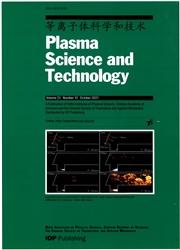HL-2A托卡马克宽光谱范围、高波长分辨率的双路发射光谱诊断
IF 1.8
3区 物理与天体物理
Q3 PHYSICS, FLUIDS & PLASMAS
引用次数: 0
摘要
摘要:为监测HL-2A托卡马克x点等离子体区的光发射,研制了一种双路光学发射光谱(D-OES)诊断方法。该诊断系统由成像系统、双路测量分束系统、光纤束、光谱仪系统、控制和采集系统组成。一条路径用于获取宽光谱范围的光谱,另一条路径用于获取高波长分辨率的线形。宽量程光谱仪的光谱分辨率为0.8 nm,覆盖800nm (@200- 1000nm)。高分辨率光谱仪光谱分辨率为0.01 nm,覆盖范围为6 nm (@200-660 nm)。D-OES每条路径的空间分辨率约为4 cm,共11个通道。在单通道模式下,时间分辨率最大为16毫秒。在实验室中,利用D-OES获得了含Balmer系列和Fulcher波段的宽光谱和高分辨的H_α谱线形状。在HL-2A的高密度氘实验中进行了D-OES测量。通过拟合测得的D_α形状,同时导出了x点MARFE区域的电子密度n_e和氘温度T_D。在38260次放电中,发生MARFE后,密度n_e从~8.7×10^18 m^(-3)增加到~7.8×10^19 m^(-3),温度T_D从~14.4 eV下降到~2.3 eV。本文章由计算机程序翻译,如有差异,请以英文原文为准。
A dual-route optical emission spectroscopy diagnostic with wide spectral range and high wavelength resolution on HL-2A tokamak
Abstract A dual-route optical emission spectroscopy (D-OES) diagnostic is newly developed to monitor the optical emission from X-point plasma region on the HL-2A tokamak. This diagnostic is composed of imaging system, beam splitting system for dual-route measurements, fiber bundles, spectrometer system, control and acquisition system. One route is used to obtain wide-spectral-range spectra, and the other route is used to acquire high-wavelength-resolution line shapes. The spectral resolution of the wide-range spectrometers is 0.8 nm with a coverage of 800 nm (@200-1000 nm). The spectral resolution of the high-resolution spectrometer is 0.01 nm with a coverage of 6 nm (@200-660 nm). The spatial resolution of each route of D-OES is about 4 cm with 11 channels. The temporal resolution is 16 ms at maximum in the single-channel mode. Wide-range spectra (containing Balmer series and Fulcher band) and highly resolved H_α line shapes are obtained by D-OES in the hydrogen glow discharge in the lab. D-OES measurements are carried out in the high-density deuterium experiments of HL-2A. The electron density n_e and deuterium temperature T_D in the X-point MARFE region are derived simultaneously by fitting the measured D_α shape. The density n_e is observed to increase from ~8.7×10^18 m^(-3) to ~7.8×10^19 m^(-3) and the temperature T_D drops from ~14.4 eV to ~2.3 eV after the onset of MARFE in the discharge #38260.
求助全文
通过发布文献求助,成功后即可免费获取论文全文。
去求助
来源期刊

Plasma Science & Technology
物理-物理:流体与等离子体
CiteScore
3.10
自引率
11.80%
发文量
3773
审稿时长
3.8 months
期刊介绍:
PST assists in advancing plasma science and technology by reporting important, novel, helpful and thought-provoking progress in this strongly multidisciplinary and interdisciplinary field, in a timely manner.
A Publication of the Institute of Plasma Physics, Chinese Academy of Sciences and the Chinese Society of Theoretical and Applied Mechanics.
 求助内容:
求助内容: 应助结果提醒方式:
应助结果提醒方式:


